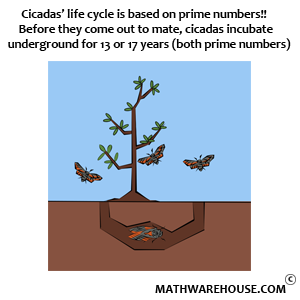Quick Overview
- Power Rule for Derivatives: $$\displaystyle \frac d {dx}\left( x^n\right) = n\cdot x^{n-1}$$ for any value of $$n$$.
- This is often described as "Multiply by the exponent, then subtract one from the exponent."
- Works for any function of the form $$x^n$$ regardless of what kind of number $$n$$ is.
Examples
Example 1---A Basic Power Function
Suppose $$f(x) = 15x^4$$. Find $$f'(x)$$.
Step 1Use the power rule.
$$ \begin{align*} f(x) & = 15x^{\blue 4}\\ f'(x) & = 15\left(\blue 4 x^{\blue 4 -1}\right)\\ & = 60x^3 \end{align*} $$
Answer$$f'(x) = 60x^3$$ when $$f(x) = 15x^4$$
Example 2---A Polynomial
Suppose $$f(x) = 2x^3 + \frac 1 6 x^2 - 5x + 4$$. Find $$f'(x)$$.
Step 1Use the power rule on the first two terms of the function. The last two terms can be differentiated using the basic rules.
$$ \begin{align*} f(x) & = 2x^{\blue 3} + \frac 1 6 x^{\blue 2} - 5\red{x} + \red 4\\[6pt] f'(x) & = 2(\blue 3 x^{\blue 3 -1}) + \frac 1 6(\blue 2 x^{\blue 2 - 1}) - 5\red{(1)} + \red 0\\[6pt] & = 6x^2 + \frac 1 3 x - 5 \end{align*} $$
Answer$$\displaystyle f'(x) = 6x^2 + \frac 1 3 x - 5$$ when $$f(x) = 2x^3 + \frac 1 6 x^2 - 5x + 4$$.
Example 3---Fractional and Negative Exponents
Suppose $$f(x) = x^{2/3} + 4x^{-6} - 3x^{-1/5}$$. $$f'(x)$$.
Step 1Use the power rule for derivatives on each term of the function.
$$ \begin{align*} f(x) & = x^{\blue{2/3}} + 4x^{\blue{-6}} - 3x^{\blue{-1/5}}\\[6pt] f'(x) & = \blue{\frac 2 3} x^{\blue{\frac 2 3} -1} + 4\blue{(-6)}x^{\blue{-6}-1} - 3\blue{\left(-\frac 1 5\right)}x^{\blue{-\frac 1 5} - 1}\\[6pt] & = \frac 2 3 x^{\frac 2 3 - \frac 3 3} - 24x^{-7} + \frac 3 5 x^{-\frac 1 5 - \frac 5 5}\\[6pt] & = \frac 2 3 x^{-1/3} - 24x^{-7} + \frac 3 5 x^{-6/5} \end{align*} $$
Answer$$\displaystyle f'(x) = \frac 2 3 x^{-1/3} - 24x^{-7} + \frac 3 5 x^{-6/5}$$ when $$f(x) = x^{2/3} + 4x^{-6} - 3x^{-1/5}$$
Example 4---Derivatives of Radicals
Suppose $$\displaystyle f(x) = \sqrt[4] x + \frac 6 {\sqrt x}$$. Find $$f'(x)$$.
Step 1Rewrite the function so each term is a power function (i.e., has the form $$ax^n$$).
$$ \begin{align*} f(x) & = \sqrt[4] x + \frac 6 {\sqrt x}\\[6pt] & = x^{1/4} + \frac 6 {x^{1/2}}\\[6pt] & = x^{1/4} + 6x^{-1/2} \end{align*} $$
Step 2Use the power rule for derivatives to differentiate each term.
$$ \begin{align*} f(x) & = x^{\blue{1/4}} + 6x^{\red{-1/2}}\\[6pt] & = \blue{\frac 1 4} x^{\blue{\frac 1 4} - 1} + 6\red{\left(-\frac 1 2\right)}x^{\red{-\frac 1 2} -1}\\[6pt] & = \frac 1 4 x^{\frac 1 4 - \frac 4 4} - 3x^{-\frac 1 2 - \frac 2 2}\\[6pt] & = \frac 1 4 x^{-3/4} - 3x^{-3/2} \end{align*} $$
Step 3 (Optional)Since the original function was written in terms of radicals, we rewrite the derivative in terms of radicals as well so they match aesthetically.
$$ \begin{align*} f'(x) & = \frac 1 4 x^{-3/4} - 3x^{-3/2}\\[6pt] & = \frac 1 4\cdot \frac 1 {x^{3/4}} - 3\cdot \frac 1 {x^{3/2}}\\[6pt] & = \frac 1 4 \cdot \frac 1 {\sqrt[4]{x^3}} - \frac 3 {\sqrt{x^3}}\\[6pt] & \frac 1 {4\sqrt[4]{x^3}} - \frac 3 {x\sqrt x} \end{align*} $$
If we rationalize the denominators as well we end up with
$$f'(x) = \frac{\sqrt[4] x}{4x} - \frac{3\sqrt x}{x^2}$$
Answer$$\displaystyle f'(x) = \frac 1 {4\sqrt[4]{x^3}} - \frac 3 {x\sqrt x} = \frac{\sqrt[4] x}{4x} - \frac{3\sqrt x}{x^2}$$ when $$\displaystyle f(x) = \sqrt[4] x + \frac 6 {\sqrt x}$$.
Example 5---Derivatives of $$\frac 1 {x^n}$$
Suppose $$\displaystyle f(x) = \frac 8 {x^{12}} + \frac 2 {x^{1.3}}$$. Find $$f'(x)$$.
Notice that $$f$$ is a composition of three functions. This means we will need to use the chain rule twice.
Step 1Rewrite $$f$$ so it is in power function form.
$$ f(x) = \frac 8 {x^{12}} + \frac 2 {x^{1.3}} = 8x^{-12} + 2 x^{-1.3} $$
Step 2Use the power rule for derivatives to differentiate each term.
$$ \begin{align*} f(x) & = 8x^{\blue{-12}} + 2 x^{\red{-1.3}}\\ & = 8(\blue{-12})x^{\blue{-12}-1} + 2(\red{-1.3})x^{\red{-1.3}-1}\\ & = -96x^{-13} - 2.6x^{-2.3} \end{align*} $$
Step 3 (Optional)Since the original function was written in fractional form, we write the derivative in the same form.
$$ f'(x) = -96x^{-13} - 2.6x^{-2.3} = -\frac{96}{x^{13}} - \frac{2.6}{x^{2.3}} $$
Answer$$\displaystyle f'(x) = -\frac{96}{x^{13}} - \frac{2.6}{x^{2.3}}$$ when $$\displaystyle f(x) = \frac 8 {x^{12}} + \frac 2 {x^{1.3}}$$.


















